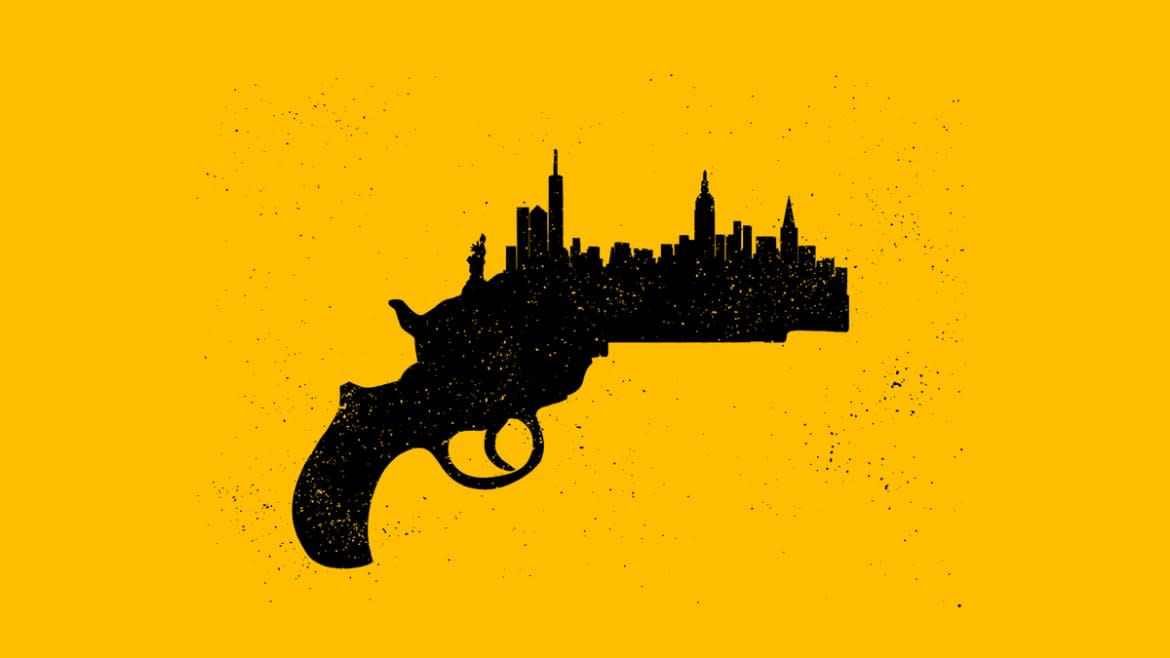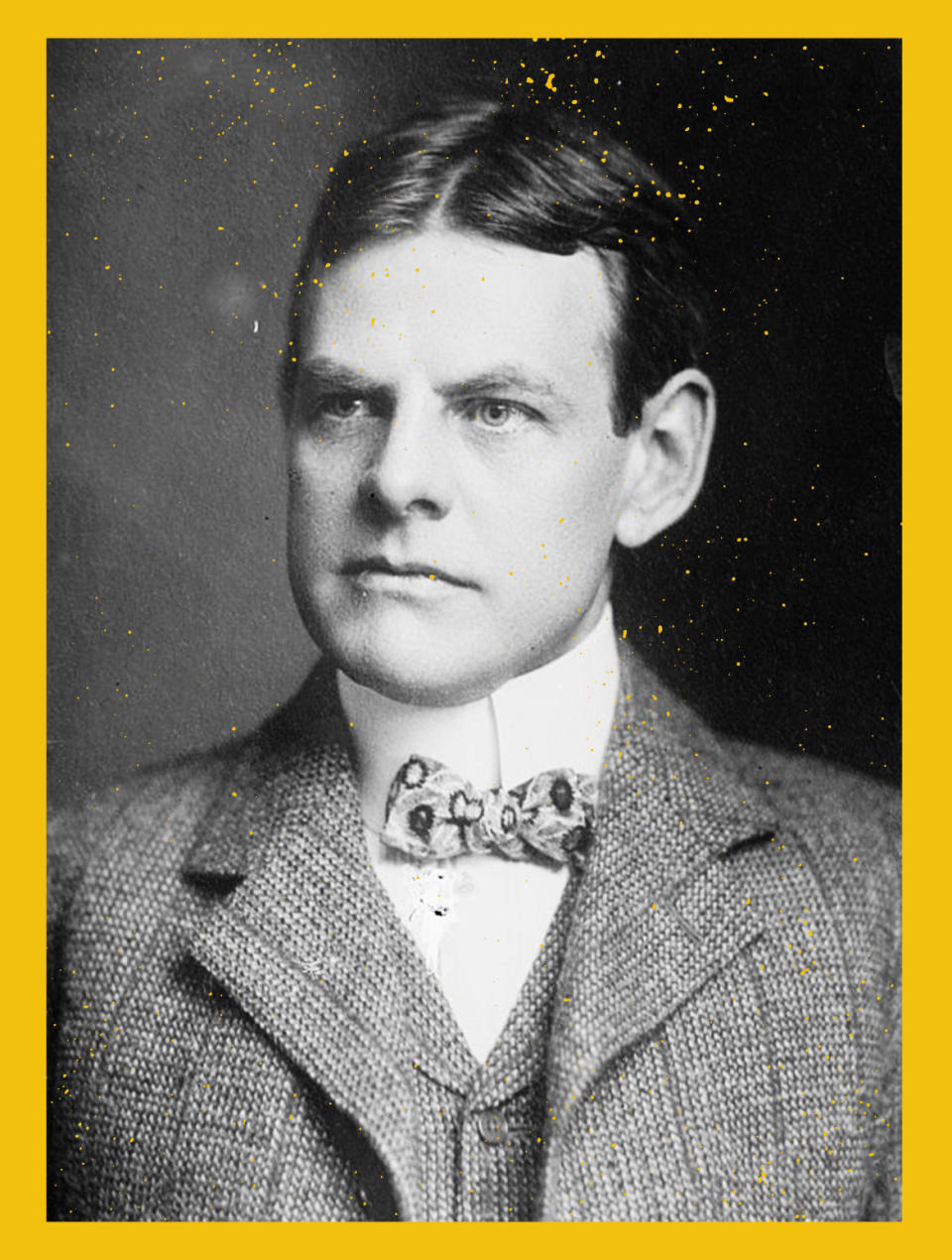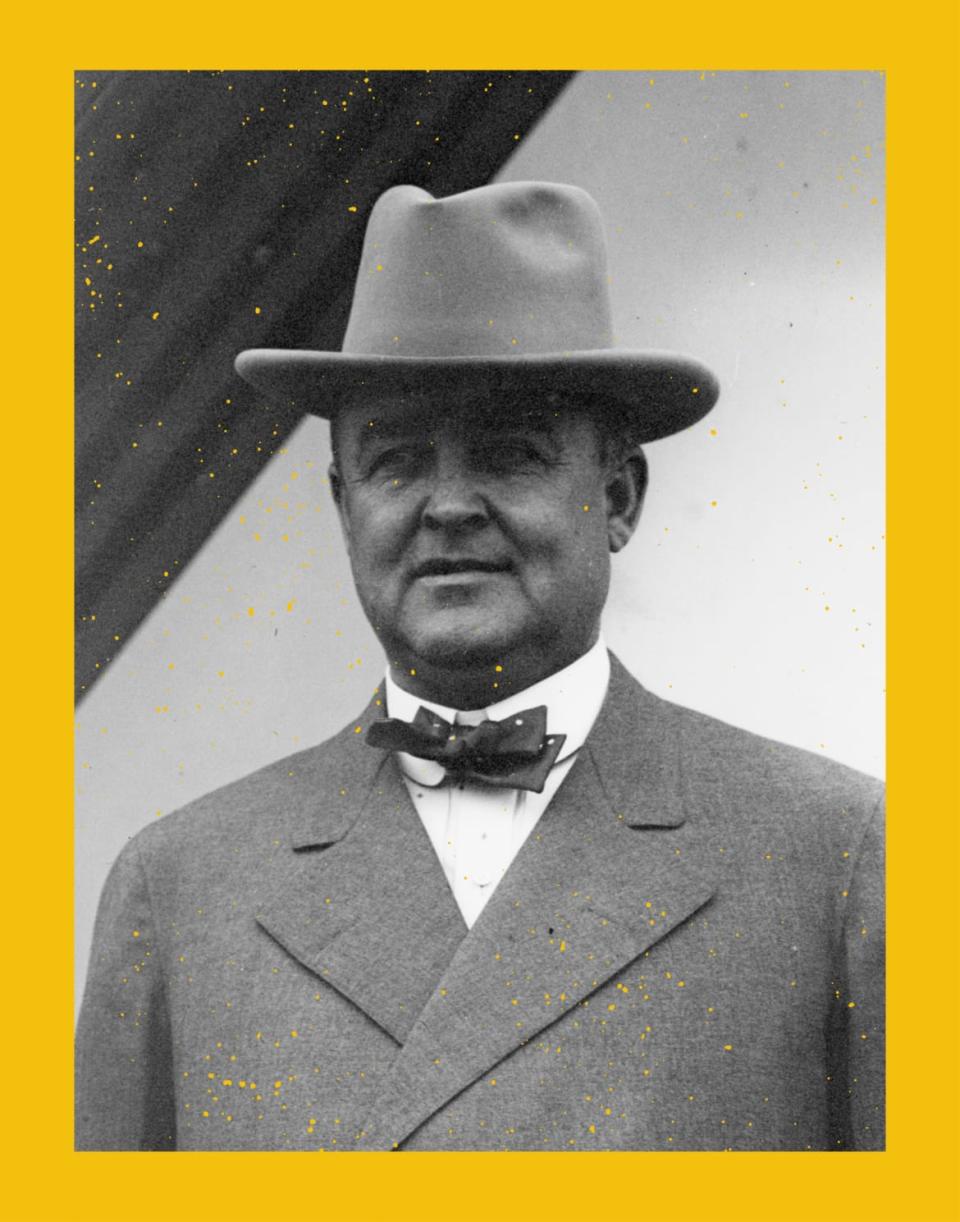Inside the Celebrity Murder Behind the Gun Law SCOTUS Just Gutted

- Oops!Something went wrong.Please try again later.
The New York gun-control law that the U.S. Supreme Court declared unconstitutional on Thursday was instituted more than a century ago after a crazed concert violinist turned failed poet shot dead a rising literary star outside the former residence of an eminent architect who had himself been shot dead some years before.
The victim whose death gave birth to the strictest gun restrictions in the nation was identified by police as David Graham Phillips, a 43-year-old novelist who had been gaining increasing critical attention. Subsequent newspaper accounts said he was striding up East 21st Street for his daily visit to the Princeton Club at 1:45 p.m. on Jan. 23, 1911, when a man suddenly stepped up and shot him five times.
The gunman, who was identified by police as Fitzhugh Coyle Goldsborough—Harvard class of 1903, masterful with a violin, but woefully uninspiring with verse—then shot himself in the right temple. Newspapers reported that his body lay at the curb as passersby carried the mortally wounded Phillips into the Princeton Club. They set Phillips down in the lobby of a building that had been the home of legendary architect Stanford White until he was shot to death five years before.
White had been killed by Henry Thaw, the jealous husband of Evelyn Nesbit. She would testify at Thaw’s trial that White had taken her as his mistress when she was just 16, on occasion placing her nude upon a red velvet swing in his studio. The murder weapon was just a mundane detail lost in headlines about of sex and seduction and celebrity and money. When Thaw was found not guilty by reason of insanity, it was widely recognized as a rich guy’s out.

Clipping from the New York American on June 26, 1906
But the homicidal violinist who killed Phillips seemed to have really been insane. Goldsborough allegedly stalked Phillips without ever meeting him. The killer was said by police to have come to falsely imagine that his family had been portrayed in one of Phillips’ novels. An entry in a notebook found on the dead gunman’s person read:
“I deem Mr. Phillips an enemy to society and personal enemy to myself.”
Without such distractions as “the girl on the red velvet swing,” a coroner’s clerk named George Petit Lebrun focused on how a manifest maniac had acquired the murder weapon.
“He simply walked in, selected the weapon he wanted, paid for it and walked out,” Lebrun later noted in It’s Time to Tell, a memoir published the year he turned 100.
LeBrun worked on both the White and Phillips murders. He had arrived at the scene of White’s killing when the murdered architect was still slumped where he had been sitting in the rooftop theater at the old Madison Square Garden shot—a building he had designed. But LeBrun was more compelled by the violent death of the novelist who was cut down five years later, just as his potential was becoming known.
“Although I knew Phillips only slightly, I was deeply shocked by his senseless death,” LeBrun wrote. “He had many years ahead of him and might have reached the greatness and brilliance critics were predicting.”

David Graham Phillips
LeBrun checked the records and saw that there had been 170 murders by firearms in Manhattan, Brooklyn, and the Bronx in 1910. He also noted that there were 917 arrests for carrying a concealed weapon, which was illegal even though there were no restrictions on purchasing a gun. He figured that the vast majority of gun toters were not caught.
“That means there were many thousands of armed men roaming the streets of the city,” he wrote. “While there was a law against carrying concealed firearms it wasn’t worth the ink used to print it since it did not prevent anybody from buying firearms. And it was only a minor violation , a misdemeanor, if you were caught.”
Supreme Court Paves Way for Even Looser Gun Laws Weeks After Uvalde Massacre
LeBrun decided that New York would do better to restrict who could get a gun in the first place.
“To me the law in existence was a perfect example of attacking a problem backwards,” he wrote. “The law should have prevented the easy purchase of firearms rather than slightly slap a man on the wrist for carrying a pistol around.”
He reached a conclusion made obvious by murder after murder by firearm.
“I reasoned that the time had come to have legislation passed that would prevent the sale of pistols to irresponsible persons,” he recalled. “In the vernacular of that day, ‘There oughta be a law.’”
LeBrun would later write that he “consulted” with someone who had the power to make such a law a reality. Timothy “Big Tim” Sullivan, was a Manhattan state senator, district leader, and, as described in the memoir, “one of the ‘power bosses’ of Tammany Hall,” the reigning Democratic political machine. LeBrun found Sullivan to be “surprisingly enthusiastic” about the need for greater gun control.”
“While Sullivan’s reasons for wanting the law did not exactly coincide with mine, they were cogent and logical,” LeBrun says.
Sullivan represented the Bowery and the Lower East Side, which were rife with gangs perennially battling each other.
“I'll do anything to stop those shootings by gangsters,” Sullivan told LeBrun, as recounted in the memoir. “It’s terrible when an innocent person is killed. Everybody runs to me and they want me to have the cops do something, as if they weren’t busy with it already. But even when gangsters kill each other, the friends and relatives come knocking on my door for money to get a lawyer and arrange bail. And they’re hardly out the door when the relatives of the victim come to me for a contribution to pay for his burial.”
Sullivan suggested that the thing to do was make carrying a concealed weapon a felony. LeBrun pointed out that this would not stop criminals and the mentally unbalanced from buying firearms.
“He then told me to draft a bill I liked and he would introduce it,” LeBrun recalled.

Timothy "Big Tim" Sullivan
LeBrun did as bid and sought a preliminary reaction from a committee of prominent citizens he had quickly formed, The League for the Preservation of Human Life. He explained that the measure would require those seeking to buy a gun to first secure a permit issued by the police. The purchaser would have to cite “proper cause,” a particular need for self-protection such as routinely carrying large sums of cash.
“I outlined the bill I had in mind and told them that if such a law had been in force, then the insane musician could not have bought the pistol used to kill the writer,” LeBrun recalled.
The members of the league gave it their full approval. The groups that were opposed included gun manufacturers and the pawn shops profiting from criminals who would repeatedly use them to stash a gun, redeem it for a fee when it was needed, and return it when they were done.
But LeBrun had the backing of Big Tim. And Sullivan caused a stir in the state Senate by breaking with his usual practice of speaking neither for nor against proposed legislation.
“He preferred to work quietly in the background,” LeBrun later wrote.
The prospect of Sullivan actually speaking from the Senate floor was so remarkable that a good many members of the Assembly crowded the spectators’ gallery to watch.
“Last Saturday night, there was a couple of gangs fighting in the street,” Sullivan began. “A mother with a baby in her arms came along and was shot dead. That alone ought to pass this bill.”
He noted that “I ain’t alone in wanting to pass this life measure.” He offered a list of supporters, who included the police commissioner and the district attorney. He cited a name that was synonymous with great wealth.
“Rockefeller,” Sullivan said, adding in what LeBrun described as a stage whisper, “That’s John D., Jr., a social acquaintance of mine.”
The chamber filled with laughter. Sullivan proceeded to invoke the Bible in his own way.
“This is a bill against murder,” he said. “[If] this bill passes, it will do more to carry out that commandment, ‘Thou shalt not kill’ than all the talk of all the ministers and priests for the next ten years.”
Sullivan finished to what was described as thunderous applause. The bill passed five months later with only five senators dissenting. It went into effect on Aug. 31 of that year, eight months and eight days after Phillips’ murder.
As happy as he was with the immediate outcome, LeBrun understood that what became known as The Sullivan Law would have only limited effect if other states did not institute similar measures.
“But the arms manufacturers now were thoroughly alarmed and began active campaigns wherever such bills were introduced,” LeBrun wrote.
Big Tim’s influence did not extend outside New York State and even if it had, he died two years later. Efforts to institute the equivalent of the Sullivan Law elsewhere largely failed. Even Franklin Roosevelt made little progress when his new National Crime Commission joined the effort in 1925. Roosevelt was president-elect seven years later when an assassin tried to kill him with a gun purchased for $8 at a Miami pawn shop. The bullet instead struck and killed Mayor Anton Cermak of Chicago.
Eventually, California, New Jersey, Maryland, Hawaii, and Massachusetts instituted variations on the Sullivan Law. But illegal guns kept pouring into New York from lax states.
LeBrun continued on with the coroner’s office until 1934, when Mayor Fiorello La Guardia forced him to retire after 36 years. He spent 16 years writing his memoir, which was published in 1962, as he turned 100. He reported that he had handled more than 100,000 deaths and that killing after killing had convinced him that the law he drafted should have been even more restrictive.
“In my own experience, I saw many store keepers who obtained permits to protect themselves against hold-ups,” he wrote. “When I saw them, they were dead, beaten to the draw by the bandit, who already had his finger on the trigger.”
LeBrun noted that the law as written had survived numerous challenges in the courts. It continued to do so after LeBrun’s death in 1966 at the age of 104. The New York State Court of Appeals most recently upheld its constitutionality in 2012.
"New York has substantial, indeed compelling, governmental interests in public safety and crime prevention," the court ruled. "The only question then is whether the proper cause requirement is substantially related to these interests. We conclude that it is."
But a new challenge by two upstate New York men reached the U.S. Supreme Court in November of last year. And during oral arguments, a majority of the justices seemed to be in favor of the appellants. New York City Mayor Eric Adams said in recent days that the impending ruling was keeping him up at night.
“We should be very afraid,” he told the press.

Mayor Eric Adams, center, takes part in a gun control protest March For Our Lives on June 11.
On Thursday morning, the court issued the opinion Adams dreaded.
“New York’s proper-cause requirement violates the Fourteenth Amendment by preventing law-abiding citizens with ordinary self-defense needs from exercising their Second Amendment right to keep and bear arms in public for self-defense,” the 6-3 opinion found.
The conservative “pro-life” majority of the justices had erased the work of LeBrun and his League for the Preservation of Human Life. Anyone without a felony record who can pass a cursory federal background check may soon be able to buy a gun in New York as easily as Fitzhugh Coyle Goldsborough did 111 years ago, just before committing the murder that gave rise to the now-overturned Sullivan law. The police and prosecutors will have to go back in time more than a century as the city moves into a future already made uncertain by COVID.
The pandemic has closed the Gramercy Park Hotel, which now stands on the former site of the building where White resided before he was shot and where Phillips was carried after he suffered the same fate. But whatever a new COVID variant might bring, the new Supreme Court verdict made gun violence the plague to worry about. The mayor—who shrugs off worries about the virus—was right to lose sleep over bullets.
Got a tip? Send it to The Daily Beast here
Get the Daily Beast's biggest scoops and scandals delivered right to your inbox. Sign up now.
Stay informed and gain unlimited access to the Daily Beast's unmatched reporting. Subscribe now.

